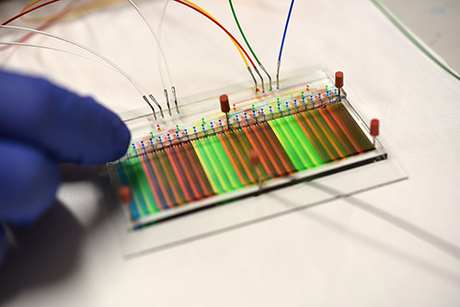Swift drug screening with a small device

Researchers from The University of Queensland (UQ) have created a high-density microbioreactor array (HDMA) — a credit card-sized device that enables cells to be cultured under thousands of different conditions simultaneously, speeding up drug screening.
Developed at UQ’s Australian Institute for Bioengineering and Nanotechnology (AIBN), the device is a microfluidic cell culture array containing 8100 culture chambers, enabling rapid screening and determination of the best conditions for growth and differentiation of induced human pluripotent stem cells (iPSCs) into diverse cell types. The benefits of the technology have been described in the journal Nature Scientific Reports.
“The current best product on the market provides individual inputs and culture chambers for drug solutions, which must be made manually,” said lead author Dr Frew Titmarsh.
“However, this design takes care of all the manual dilution and mixing onboard the chip, and allows us to generate a whole spectrum of conditions and run them in 8100 experimental chambers in parallel.” It would ordinarily take three to six months to conduct these experiments with standard experimental protocols.
“It has allowed us to optimise media formulations for a range of iPSC differentiation outcomes, including cardiac, bone, kidney [and] muscle, and we’re applying it to a multitude of other differentiation end points,” said project leader Professor Justin Cooper-White, who added that the approach also provides a substantial economic benefit.
“In bioprocess development for cell therapies, one of the biggest costs is cell culture media,” he said. “This device can be used to cut down that cost, which enhances the biological outcome substantially.
“Rather than doing one test at a time, we can survey thousands of different environments and rapidly understand how cells respond to drug agents. We have shown that the high-density microbioreactor array can rapidly zero in on optimum conditions for cell expansion or differentiation, with savings of at least 10- to 500-fold.”
The HDMA was designed to be used with all standard cell biology/molecular biology techniques and tools, such as microscopy, confocal and super resolution. The team is now further developing the technology to make it to be compatible with existing laboratory systems and giving it plug-and-play capabilities.
With the approach having already been validated in laboratories at University College London and A*STAR in Singapore, Professor Cooper-White is now seeking support to commercialise his team’s device.
Three-in-one pill could transform hypertension treatment
Australian research has produced impressive Phase III clinical trial results for an innovative...
AI-designed DNA switches flip genes on and off
The work creates the opportunity to turn the expression of a gene up or down in just one tissue...
Drug delays tumour growth in models of children's liver cancer
A new drug has been shown to delay the growth of tumours and improve survival in hepatoblastoma,...




